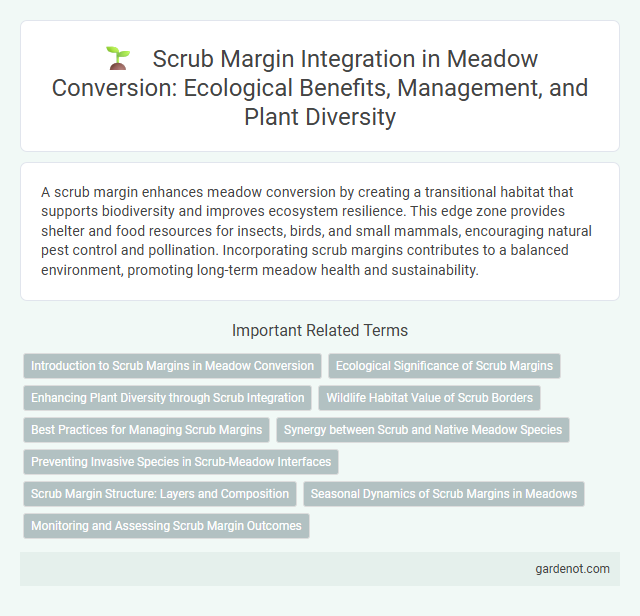A scrub margin enhances meadow conversion by creating a transitional habitat that supports biodiversity and improves ecosystem resilience. This edge zone provides shelter and food resources for insects, birds, and small mammals, encouraging natural pest control and pollination. Incorporating scrub margins contributes to a balanced environment, promoting long-term meadow health and sustainability.
Introduction to Scrub Margins in Meadow Conversion
Scrub margins are transitional zones between open grassland and dense shrub or woodland, playing a crucial role in meadow conversion by enhancing biodiversity and habitat complexity. These areas support a diverse range of flora and fauna, including pollinators, birds, and small mammals, contributing to ecological resilience. Effective management of scrub margins involves balancing scrub encroachment to maintain open meadow characteristics while providing shelter and resources.
Ecological Significance of Scrub Margins
Scrub margins serve as vital ecological buffers between meadows and woodland habitats, supporting high biodiversity by providing shelter and foraging grounds for numerous invertebrates, birds, and small mammals. These transitional zones enhance nutrient cycling and soil stabilization, contributing to the overall health of adjacent meadow ecosystems. Maintaining diverse scrub species within these margins is essential for promoting pollinator populations and sustaining complex food webs.
Enhancing Plant Diversity through Scrub Integration
Scrub margin integration enhances plant diversity by providing varied microhabitats that support a broader range of flora, including shade-tolerant and nitrogen-fixing species. Incorporating native scrub species like hawthorn and blackthorn creates structural heterogeneity, promoting ecological niches for wildflowers and grasses. This approach boosts ecosystem resilience by increasing seed sources and improving pollinator attraction within meadow conversions.
Wildlife Habitat Value of Scrub Borders
Scrub margins provide critical wildlife habitat value by offering shelter and breeding sites for diverse species such as birds, insects, and small mammals. These transitional zones between meadow and woodland promote biodiversity by supporting pollinators and predator-prey dynamics. Maintaining dense, native shrub growth within scrub margins enhances their ecological function and contributes to overall meadow ecosystem health.
Best Practices for Managing Scrub Margins
Scrub margins are vital for enhancing biodiversity and supporting wildlife habitats in meadow conversion projects. Best practices for managing scrub margins include maintaining a varied height to provide shelter and foraging opportunities, periodic rotational cutting to prevent overgrowth, and retaining native shrub species to encourage pollinators and birds. Careful monitoring and adaptive management ensure scrub margins contribute to ecological resilience while preventing encroachment into open meadow areas.
Synergy between Scrub and Native Meadow Species
Scrub margins create vital microhabitats that enhance biodiversity by providing shelter and food resources for native meadow species. The structural complexity of scrub supports pollinators and seed dispersers, fostering a dynamic interaction that promotes plant regeneration and ecosystem resilience. This synergy between scrub and native meadow vegetation optimizes habitat connectivity and boosts overall ecological health.
Preventing Invasive Species in Scrub-Meadow Interfaces
Maintaining a dense scrub margin is crucial for preventing invasive species from encroaching into meadow areas by creating a natural barrier that limits seed dispersal. Regular monitoring and selective removal of invasive plants at the scrub-meadow interface protect native biodiversity and preserve ecosystem balance. Implementing native shrub planting enhances resilience against invasives while supporting habitat connectivity for local wildlife.
Scrub Margin Structure: Layers and Composition
Scrub margin structures consist of multiple vegetation layers, including shrub species, young trees, and herbaceous plants, creating a complex habitat with diverse flora and fauna. The composition typically features dense undergrowth combined with patches of open ground, promoting biodiversity and supporting pollinators and small mammals. This layered arrangement enhances soil stabilization and acts as a transitional buffer between meadows and woodlands during meadow conversion projects.
Seasonal Dynamics of Scrub Margins in Meadows
Scrub margins in meadows exhibit pronounced seasonal dynamics, with vegetation density and species composition shifting throughout the year. Spring and early summer typically see vigorous growth of herbaceous species and budding shrubs, enhancing habitat complexity and supporting diverse pollinators. By late summer and autumn, increased woody shrub dominance creates structural variation crucial for nesting birds and small mammals during colder months.
Monitoring and Assessing Scrub Margin Outcomes
Monitoring and assessing scrub margin outcomes involves regular surveys to track vegetation changes and biodiversity levels, ensuring the scrub does not encroach excessively into the meadow. Detailed assessments include species composition analysis and habitat quality evaluations to gauge the success of scrub management strategies. Data collected supports adaptive management, optimizing scrub margins for enhanced ecological value and meadow restoration goals.
Scrub margin Infographic

 gardenot.com
gardenot.com